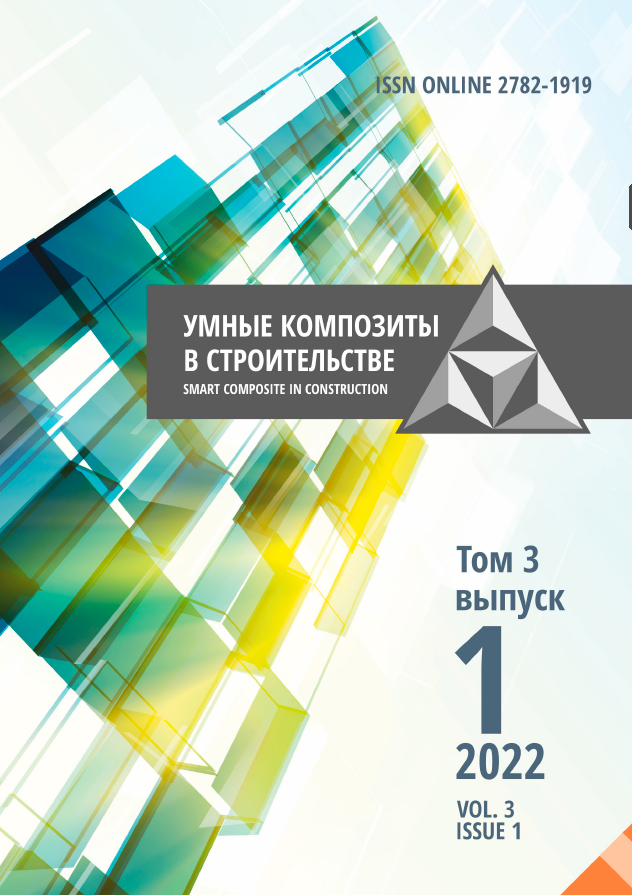Ivanovo, Ivanovo, Russian Federation
Ivanovo, Ivanovo, Russian Federation
Ivanovo, Ivanovo, Russian Federation
The article considers the problem of the composite structure optimization developed on the basis of general theoretical concepts about the dependence of the performance characteristics of composite materials on their composition and structure. Based on the poly-structural theory of concrete, the article formulates provisions on the influence of components on different structural levels of the composite and experimentally proves the possibility of qualitative control of material properties and characteristics of final urban infrastructure objects based on them. This article discusses existing and promising methods for creating variatropic polystructured composite materials. The paper presents the results of experiments on the selection of composite structure considering this particular structure as a complex system. Also the paper provides the experimental results on optimization of composite structure. These results allow efficient cooperation of the heterogeneous material elements and rational management of the properties of the final object of the urban infrastructure, taking into account the requirements for operating conditions. The authors also propose the technological solutions for the production of environment objects made of the developed composite material.
construction materials, composites, composite materials, polystructural integration, polystructural theory of concrete, concrete, variatropic structure
1. MGSN 1.02-02 / TCH 30-307-2002 Norms and rules for the design of complex landscaping on the territory of the city of Moscow (as amended on August 19, 2003, July 11, 2006) (in Russian).
2. Silkina, M.A. (2015) Visual landmarks in the architectural environment, Nauka, obrazovanie i eksperimental'noe proektirovanie: tezisy dokladov Mezhdunarodnoj nauchno-prakticheskoj konferencii professorsko-prepodavatel'skogo sostava, molodyh uchenyh i studentov, April 6-10, 2015. M.: MARHI, pp. 417-418 (in Russian).
3. Skuratovskij, G.M. (1997) The Art of Architectural Proportionation. Novosibirsk: Nauka: Sibirskoe predpriyatie RAN (in Russian).
4. Pomazkin, A.I., Kravchenko, V.A., Kuchina, K.A., Litvintsev, M.K., Putykh, A.V. & Uspenskikh, A.V. (2019) Technological and financial advantages of composite materials from natural raw materials, Ekonomika: vchera, segodnya, zavtra, 9(5A), pp. 335-343 (in Russian).
5. Hozin, V.G. (2014) Polymers in construction – real boundaries and prospects for effective use, Polimery v stroitel'stve: nauchnyj Internet-zhurnal, 1(1), pp. 9-26 [online]. Available at: https://polymer.kgasu.ru/files/N1-1-2014-vypusk-17.03.pdf (in Russian).
6. Bozhenov, P.I. (1992) On the formation of technical characteristics of polydisperse artificial materials, Stroitel'nye Materialy, 4, pp. 20-24 (in Russian).
7. Dvorkin, L.I., Solomatov, V.I., Vyrovoj, V.N. & CHudnovskij, S.M. Cement concretes with mineral fillers. Kiev: Budivel'nik, 1991 (in Russian).
8. Dvorkin, L.I. (1988) Effect of active fillers in plasticized cement concretes, Izv. Vyssh. Uchebn. Zaved. Stroitel'stvo i arhitektura, (9), pp. 53-57 (in Russian).
9. Ovchinnikov, A.A., Obruchev, D.V. & Danilov, I.N. (2021) Composite materials based on polysturctural integration of heterogeneous materials, Smart composite in construction, 2(3), pp. 21-31.
10. Solomatov, V.I. (1985) Development of the polystructural theory of composite building materials, Izv. Vyssh. Uchebn. Zaved. Stroitel'stvo, (8), pp. 58-64 (in Russian).
11. Solomatov, V.I., Vyrovoj, V.N., Bobryshev, A.N. et al. (1991) Polystructural theory of composite building materials. Tashkent: FAN (in Russian).
12. Korolev, E.V., Bazhenov, Yu.M. & Smirnov, V.A. (2011) Building materials of variatropic-frame structure. M.: MGSU (in Russian).
13. Nalimov, V.V. (1969) 'Theory of experiment' in Nalimov, V.V. (Ed.) New ideas in experiment planning. M.: Nauka, pp. 24-36 (in Russian).
14. Nalimov, V.V. & Chernova, N.A. (1965) Statistical methods for planning extreme experiments. M.: Nauka (in Russian).
15. Adler, Yu.P., Markova, E.V. & Granovskij, Yu.V. (1971) Experiment planning while searching for optimal conditions. M.: Nauka (in Russian).
16. Smirnov, N.V. & Dunin-Barkovskij, I.V. (1969) Probability Theory and Mathematical Statistics course (for technical applications). M.: Nauka (in Russian).
17. Finni, D. (1970) Introduction to the theory of experiment planning. M.: Nauka (in Russian).







